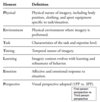B.4 - Psychology of sports Flashcards
What is psychological skills training? (PST)
It is the systematic and consistent practice of mental psychological skills
What are the 5 main points for PST?
PST skills need to be developed, e.g. (concentration, confidence)
PST is not only practiced by elite athletes however can be practiced by anyone.
PST is not only to do with sports it can be for anyone however common in sports
PST does not quickly give a solution. One has to practice for a long period of time to achieve the skills
PST is normally set in three different stages, education, acquisition, and practice.
What are the three main phases of PST?
Educational Phase
Acquisition Phase
Practice Phase
Define the educational phase
This phase consists of the psychological skills being learned and practiced. It takes time to develop and refine these skills over time. It is used to clarify what psychological skills are, how they can be trained, what level of commitment is required, what improvement such training can bring.
Define the acquisition phase
This phase is used to focus on strategies and techniques for learning the different psychological skills. This aspect of the training program needs to be tailored to meet the individual’s needs.
Define the practice phase
This phase consists of the transferring of psychological skill from practice and simulated situations to actual competitions. The focus should be on making the psychological skills automatic.
What is goal setting?
Goal setting helps with motivation for the individual and can also give confidence to the individual.
What is SMARTER?
S - specific
M - measurable
A - achievable
R - realistic
T - time-bound
E - evaluate
R - review/readjust

What are the three different types of Goals
Process goals
performance goals
Outcome goals
Outline Process goals
Deal with the technique or strategy necessary to perform well. The individual has complete control.
Example:
maintain controlled rhythm in the long jump run up
Outline performance goals
Specify a specific standard to be achieved. Focused on achievement independent of other competitors.
Example:
Run a 400 m sprint at a given time.
Outline outcome goals
About winning or performing better than someone else. They refer to the desired end result.
Example:
winning the game
Define mental Imagery
Mental imagery involves the athlete imagining themselves in an environment performing a specific activity using all of their senses (sight, hear, feel and smell). The images should have the athlete performing successfully and feeling satisfied with their performance.
What is mental imagery associated with?
Mental imagery is associated with concentration enhancement, self- confidence, skill acquisition, emotional control, practice strategy, and coping with pain and injury.
What are the two different types of mental imagery?
Internal and external
Define internal imagery
Visualizing yourself as the person actually going through the motions. It allows you to have a keen awareness of how it feels to do things the correct way.
Define external imagery
(as if you are a spectator or watching a video of yourself) is good for error correction, this way you can see what it is you are actually doing wrong.
What does PETTLEP stand for?
Physical, Environment, Task, Timing, Learning, Emotion, perspective

What is associated with relaxation?
Relaxation is associated with arousal regulation, reducing somatic and cognitive anxiety.
what is self talk
Self-talk is one talks out loud to oneself, there can be both be positive and negative self-talk
Examples of positive self-talk
motivational: keep performers focused and confident
instructional: remind performer about technique
Examples of negative self-talk
self-critical
remembers past events
pessimistic
can induce self-fulfilling prophecy
What is thought stopping?
Thought stopping is when one stops negative thoughts while they are performing


